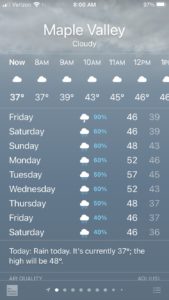Liturgy Lessons: November 15, 2020
Morning Worship (9 and 11 a.m.)
Call to Worship: Psalm 98
Prayer of Invocation
Hymn of Adoration: Our Great God
Confession of Sin: Malachi 4:1-2a and prayer
Assurance of Pardon: Titus 3:4-7 and Isaiah 12:1-2, 6
Hymn of Assurance: Blessed Assurance
Catechism/Prayers
Reading of the Word: Luke 21:5-24
Doxology: #731
Sermon: Rev. Eric Irwin
Meditation
The Lord’s Supper: Lo! He Comes with Clouds Descending; At the Lamb’s High Feast We Sing
Benediction
“That, if then I had waked after a long sleep,
will make me sleep again; and then, in dreaming,
the clouds methought would open and show riches
ready to drop upon me; that, when I waked I cried to dream again.”
– William Shakespeare, “The Tempest”
“You fearful saints, fresh courage take;
the clouds you so much dread are big with mercy,
and shall break in blessing on your head.”
– William Cowper
Let’s talk about clouds. What is your first response when you see a forecast like this?

Blah, right? It certainly elicits more of a “yuck!” than a “yippee!” and may even be downright depressing. The darker days of fall and winter usher in a gray pall that can have a serious impact on how we feel and function. There is even a medical diagnosis for this. Seasonal Affective Disorder (SAD) is a real thing out here in Seattle where people hunker down during the rainy months and attempt to cope with coffee and vitamin D supplements.
This year it is more than just the change in weather bringing the doldrums. There are real storm clouds on the horizon. The poisoned air of the pandemic has now mixed with social, economic, and political instability to create a cultural cumulonimbus. The clouds that hang over us these days carry real threat of impending darkness. This demands that we do more than simply cope.
This week’s hymn reminds us that the foreboding clouds carry within them a real hope. It suggests that we look at the clouds in a different light, not searching for a silver lining, but seeing in their substance a sign and symbol of their Maker. In truth, the Bible constantly speaks of the clouds as being saturated with the glory and presence of God.
“Do you know the balancings of the clouds,
the wondrous works of him who is perfect in knowledge?”
– Job 37:16
“His way is in whirlwind and storm, and the clouds are the dust of his feet.”
– Nahum 1:3
“Clouds and thick darkness are all around him;
righteousness and justice are the foundation of his throne.”
– Ps. 97:2
“He lays the beams of his chambers on the waters;
he makes the clouds his chariot; he rides on the wings of the wind.”
– Ps. 104:3
This is no mere symbolism, and certainly no joke. It is sirrus stuff! History shows that the clouds signify not only the awesome power of God, but also his immanent presence in time and space. Noah knew this before and after the flood (Gen. 9:14-16). Moses saw it on the mountaintop (Ex. 24:15-16). Indeed, all the Israelites were witnesses to it in the wilderness (Ex. 13:21). If we go all the way back to the beginning of Genesis, we find a description of creation that compares the Spirit of God to a cloud “hovering over the face of the waters.” And, of course, the Lord himself ascended in a cloud (Acts 1:9), something that was foretold by Daniel (Dan. 7:13-14). Likewise, the Scriptures tell us that “He is coming with clouds, and every eye will see Him, even those who pierced Him” (Rev. 1:7). Which leads us to our hymn…
Lo, He Comes With Clouds Descending
Text: Charles Wesley (1758)
Music: POLOMEO, Ross Hauck (2020)
In 1750, the Methodist and Moravian evangelist John Cennick wrote an Advent hymn that began, “Lo! he cometh, countless trumpets blow before his bloody sign!” That’s quite a title! Cennick was friends with John and Charles Wesley. Charles got a hold of Cennick’s hymn and substantially rewrote it, lending his superior skill to the original six verses. Wesley whittled the hymn down to four sublime stanzas and published it in 1758 under the new title “Thy Kingdom Come” (later changed to “The Second Advent”). Most hymnals present a combination of the two texts. For various historical, aesthetic, and contextual reasons, I have decided to revert to Wesley’s version. I hope this is not a mere act of hubris toward the hymnal gods. If so, then I have provoked their wrath even further by resetting the original text to a new tune. May they have mercy upon me.
Be assured that the leeway I’ve taken with this hymn is only afforded me because I’m American. Were I the music director of a church in England, making such radical alterations to this particular hymn would be an act of treason against the Empire. According to a survey dating back to 1885, this hymn is considered one of the “Great Four Anglican Hymns” Those four are:
“All Praise to Thee, My God, This Night” by Thomas Ken
“Hark! The Herald Angels Sing” by Charles Wesley
“Lo! He Comes With Clouds Descending” by Charles Wesley
“Rock of Ages, Cleft for Me” by Augustus Montague Toplady
Across the pond, this beloved hymn text has, for quite some time, been indelibly linked to the tune Helmsley. The Bishop of Durham recalled in 1901 that Queen Victoria was displeased after an organist played a different tune at Windsor Castle and requested only Helmsley in future.
Well, now I have transgressed both the authorities and aristocracy. Be assured it is not out of disdain for tradition. I actually love the tune Helmsley, and in certain contexts I prefer it. It is a beautifully florid melody befitting a cathedral. Its elaborate shape and flowing lines are enchanting when performed by a trained choir and congregation (listen here). It is a true singer’s melody. Perhaps we will try it in our humble Issaquah chapel someday.
But for now, I have written something simpler and more stark. This is for two reasons. First, I want our congregation to run on a track that is cleared of musical hurdles, opening our hearts and lungs in full stride without worrying about tripping over this or that melisma (a group of notes sung to one syllable of text). Second, I wanted to try my hand at a melody that captured the darker overtones of the Second Coming. Read this apocalyptic Wesley text (so clearly based on Rev. 1:7) and tell me if all you see and hear is bright colors and brass fanfare:
Lo! He comes with clouds descending,
Once for favour’d sinners slain!
Thousand, thousand saints attending,
Swell the triumph of his train:
Hallelujah! Hallelujah!
God appears, on earth to reign!
Every eye shall now behold Him
Rob’d in dreadful majesty,
Those who set at nought and sold Him,
Pierc’d, and nail’d Him to the tree,
Deeply wailing! Deeply wailing,
Shall the true Messiah see.
The dear tokens of his passion
Still His dazzling body bears,
Cause of endless exultation
To his ransom’d worshippers;
O what rapture! O what rapture
Gazing on those glorious scars!
Yea, amen! let all adore Thee
High on thine eternal throne!
Saviour, take the power and glory,
Claim the kingdom for thine own:
Great Jehovah! Great Jehovah,
Everlasting God, come down.
When I read that, I don’t see puffy white clouds shaped like dolphins. I see this:

This calls for more than just major chords and romantic cadences. I felt it needed something with more fury than pomp. So, I wrote a new tune (instrumental version below) and decided to name it Polomeo, a transliteration of the original Greek meaning “to make war.”
“I saw heaven opened, and behold, a white horse!
The one sitting on it is called Faithful and True,
and in righteousness he judges and makes war.”
– Rev. 19:11
Scripture is pretty clear. When the white horse and its Rider split the fabric of the universe at the seams and tear into our sky upon the chariot-clouds, it will be a Dies Irae (Day of Wrath). It will be a terrifying, stupendous, staggering sight to behold. For some, it will be nothing but doom and destruction. But for those of us who know Christ, we will rejoice to see him in full glory as the sun of righteousness astride those fearsome clouds. This will be for us a sign not of terror, but of triumph. On that day, our Head will literally be in the clouds, and we will live forever with him on cloud nine. Hallelujah! Come quickly, Lord Jesus, Come!
– Lead sheet
– Recording
